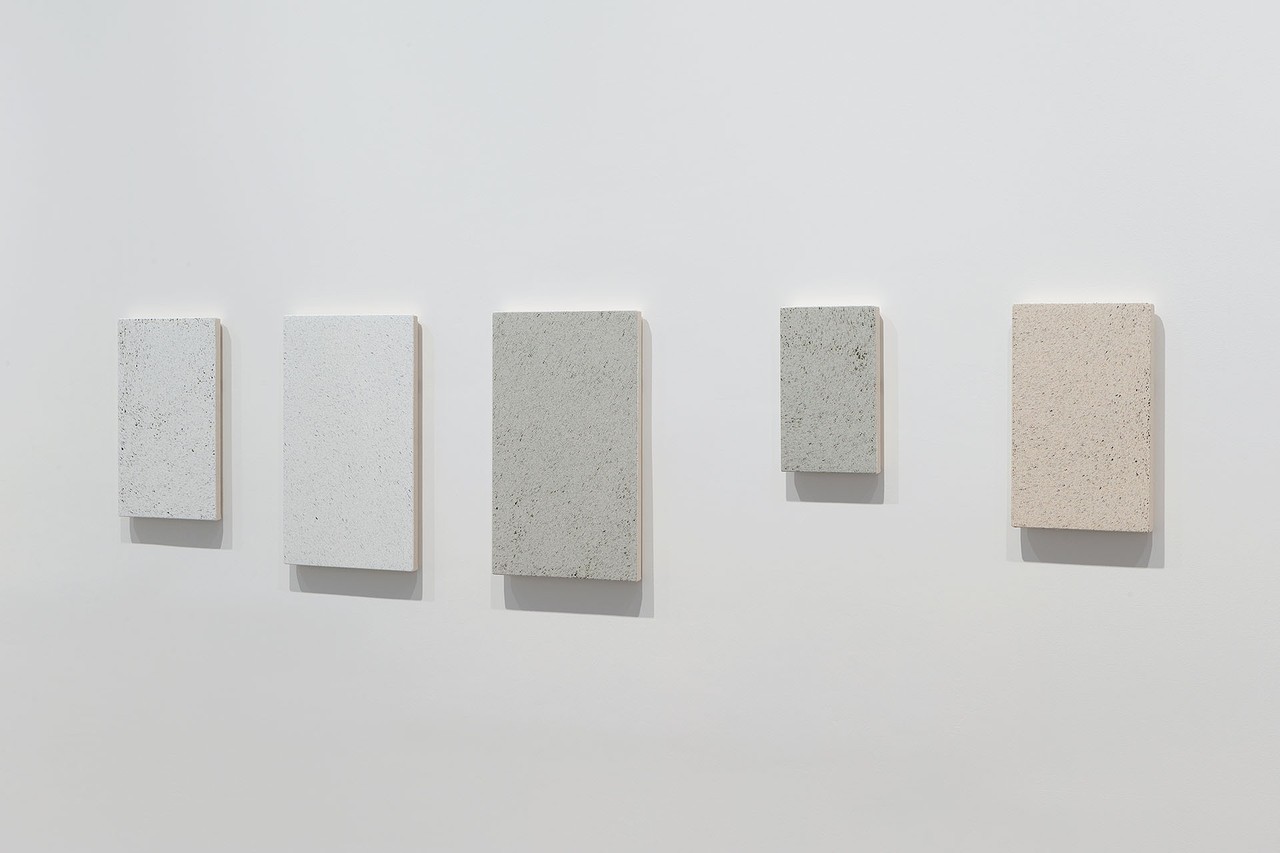Jacob Kassay
(you)
10 Sep - 22 Oct 2016
JACOB KASSAY
(you)
10 September - 22 October 2016
Art:Concept is pleased to announce Jacob Kassay’s third exhibition at the gallery Jacob Kassay (you).
Kassay’s new group of work enfolds the mediating apparatus of the camera into the surface and scale of paintings, thickening the lens and formats through which they are imaged. Scaled to the fixed ratio of the camera’s viewfinder, the paintings are objects fundamentally shaped by their documentation, sized at even intervals which expand and contract to fit the immanent window of the photo. In making manifest and multiplying the camera’s otherwise implicit, standardized frame, Kassay’s paintings - ranging from palm to head size - acutely stress how a work’s dimensions become tailored to be photogenic, built to traffic on screens.
While the scaling of Kassay’s paintings stages a smooth interfacing with the camera, their surfaces upend this calibration. At a distance, the paintings present mute, uniform colors which then dissolve into a pixellated field of multicolored flecks when approached. Rendering physical the compressing effect of resolution, this positional shift of the painting’s surface from solid to diffuse is only active in embodied experience, variable states which lie dormant in documentation.
As Kassay’s paintings elude the fixity of image in their oscillating opacity, their surfaces are inscribed by the camera, doubling it’s capture back on itself. The darkest pixels from the paint’s arbitrary speckle pattern are stamped over the original surfaces, creating a blurred mis-registration between the copied information and their source. Stammering the paintings’ surfaces, exerting friction against their seamless backgrounds, this duplication of the pattern induces a disorienting, retinal schism where one struggles to isolate the layers of scattered points creased over themselves. In their stereoscopic misalignment between randomly dispersed pigment and its double, Kassay’s paintings react internally against their processing as image, turning the multiplication of their surfaces into pixellated noise.
While Kassay’s paintings are contiguous with the external apparatus of the camera, projecting its dimensions outward to the wall in canvas, the exhibition includes a sculpture which works inversely, modeling an interior volume embedded within the fixed scale of the body. Rendered from CT scans of a nasal sinus cavity and cast in lead, the sculpture (1:1(psig), 2016) is set inside a wall of the gallery, hardening the head’s passages into a solid toxic mass. Parallel to the way that the painting’s patterns rupture internally, stymieing the coherence of the image, Kassay’s sculpture acts as a material compression of the space of breathing, an insensible void which only becomes felt when the automatic operation that governs it is interrupted.
In conjunction with the exhibition, Paul Sharits’ APPARENT MOTION (1975) will be projected in the space during the ending of the show (October 20th), presenting a filmic analog to the work on view in their mutual emphasis on the scale of the camera, particulate materiality and retinal shifts.
(you)
10 September - 22 October 2016
Art:Concept is pleased to announce Jacob Kassay’s third exhibition at the gallery Jacob Kassay (you).
Kassay’s new group of work enfolds the mediating apparatus of the camera into the surface and scale of paintings, thickening the lens and formats through which they are imaged. Scaled to the fixed ratio of the camera’s viewfinder, the paintings are objects fundamentally shaped by their documentation, sized at even intervals which expand and contract to fit the immanent window of the photo. In making manifest and multiplying the camera’s otherwise implicit, standardized frame, Kassay’s paintings - ranging from palm to head size - acutely stress how a work’s dimensions become tailored to be photogenic, built to traffic on screens.
While the scaling of Kassay’s paintings stages a smooth interfacing with the camera, their surfaces upend this calibration. At a distance, the paintings present mute, uniform colors which then dissolve into a pixellated field of multicolored flecks when approached. Rendering physical the compressing effect of resolution, this positional shift of the painting’s surface from solid to diffuse is only active in embodied experience, variable states which lie dormant in documentation.
As Kassay’s paintings elude the fixity of image in their oscillating opacity, their surfaces are inscribed by the camera, doubling it’s capture back on itself. The darkest pixels from the paint’s arbitrary speckle pattern are stamped over the original surfaces, creating a blurred mis-registration between the copied information and their source. Stammering the paintings’ surfaces, exerting friction against their seamless backgrounds, this duplication of the pattern induces a disorienting, retinal schism where one struggles to isolate the layers of scattered points creased over themselves. In their stereoscopic misalignment between randomly dispersed pigment and its double, Kassay’s paintings react internally against their processing as image, turning the multiplication of their surfaces into pixellated noise.
While Kassay’s paintings are contiguous with the external apparatus of the camera, projecting its dimensions outward to the wall in canvas, the exhibition includes a sculpture which works inversely, modeling an interior volume embedded within the fixed scale of the body. Rendered from CT scans of a nasal sinus cavity and cast in lead, the sculpture (1:1(psig), 2016) is set inside a wall of the gallery, hardening the head’s passages into a solid toxic mass. Parallel to the way that the painting’s patterns rupture internally, stymieing the coherence of the image, Kassay’s sculpture acts as a material compression of the space of breathing, an insensible void which only becomes felt when the automatic operation that governs it is interrupted.
In conjunction with the exhibition, Paul Sharits’ APPARENT MOTION (1975) will be projected in the space during the ending of the show (October 20th), presenting a filmic analog to the work on view in their mutual emphasis on the scale of the camera, particulate materiality and retinal shifts.

